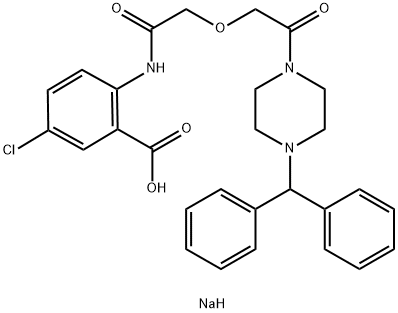1103926-82-4
 1103926-82-4 結(jié)構(gòu)式
1103926-82-4 結(jié)構(gòu)式
基本信息
PAI-1抑制劑(TM5275 SODIUM)
TM 5275
TM 5275
TM-5275
TM5275 (sodium)
TM 5275 sodium salt
TM5275 sodium salt >=98% (HPLC)
2-(2-(2-(4-benzhydrylpiperazin-1-yl)-2-oxoethoxy)acetamido)-5-chlorobenzoic acid sodium salt
5-Chloro-2-[[2-[2-[4-(Diphenylmethyl)-1-piperazinyl]-2-oxoethoxy]acetyl]amino]benzoic acid sodium salt
物理化學(xué)性質(zhì)
DMF:PBS (pH 7.2) (1:8):0.11(Max Conc. mg/mL);0.2(Max Conc. mM)
DMF:33.0(Max Conc. mg/mL);60.66(Max Conc. mM)
安全數(shù)據(jù)
常見(jiàn)問(wèn)題列表
| Target | Value |
|
PAI-1
(Cell-free assay) | 6.95 μM |
Docking studies shows that TM5275 binds to strand 4 of the A β-sheet (s4A) position of PAI-1. TM5275 is a selective PAI-1 and (up to 100?μM) does not interfere with other serpin/serine protease systems. TM5275 at concentrations of 20 and 100 μM significantly prolongs the retention of tPA-GFP on VECs by inhibiting tPA-GFP-PAI-1 high-molecular-weight complex formation. TM5275 enhances the time-dependent accumulation of plasminogen as well as the dissolution of fibrin clots on and around the tPA-GFP-expressing cells. Cell viability at 72 h treatment is decreased with 70-100 μM TM5275 in ES-2 and JHOC-9 cells. From 48 h up to 96 h, cell growth is suppressed with 100 μM TM5275. Active PAI-1 in cell culture media is significantly decreased in cells treated with 100 μM TM5275 compared to control treatment. TM5275 is suggested to exert anti-proliferative effects in ovarian cancer with high PAI-1 expression.
TM5275 exhibits a favorable pharmacokinetics profile and very low toxicity to mice and rats. In rat thrombosis models. Blood clot weights are significantly lower in rats administered 10 and 50?mg/kg of TM5275 (60.9±3.0 and 56.8±2.8?mg, respectively) than in vehicle-treated rats (72.5±2.0?mg). The antithrombotic effectiveness of TM5275 (50?mg/kg) is equivalent to that of ticlopidine (500?mg/kg), a reference antithrombotic compound. Plasma concentration of TM5275 reaches 17.5±5.2?μM after a dose of 10?mg/kg. TM5275 (5?mg/kg) combined with tPA (0.3?mg/kg) significantly enhances the antithrombotic effect of tPA (0.3?mg/kg) alone and provides a benefit similar to that of a high tPA dose (3?mg/kg).

